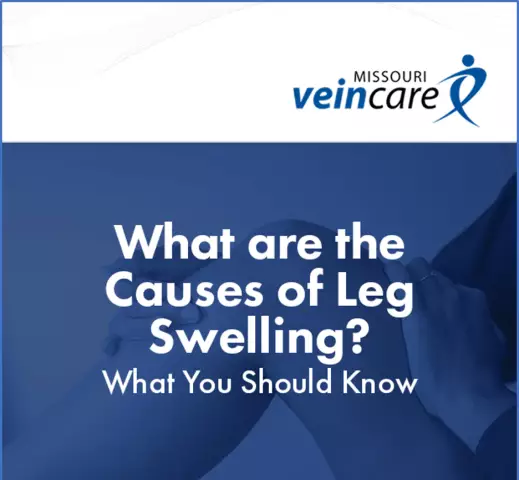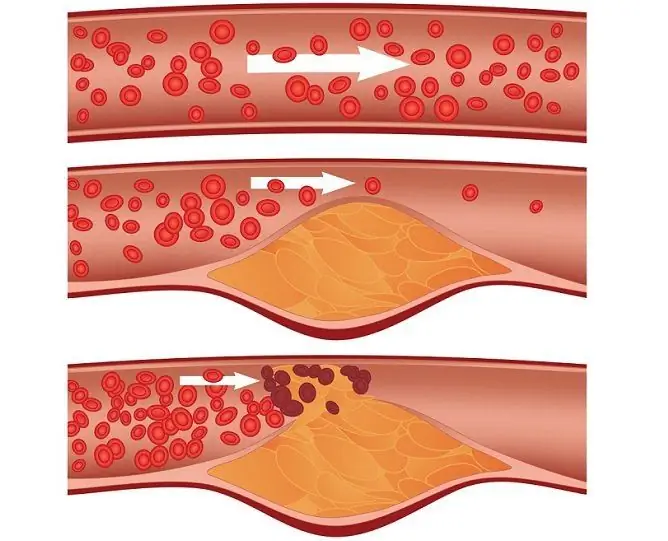- Author Rachel Wainwright [email protected].
- Public 2023-12-15 07:39.
- Last modified 2025-11-02 20:14.
11 main causes of leg swelling
Many people are familiar with such an unpleasant phenomenon as swelling of the legs. Most often, the problem quickly disappears by itself, it is enough just to give your legs a rest for a few hours. It is much worse when edema occurs regularly, accompanied by pain, discoloration of the skin and other alarming symptoms. This could be a sign of one of the diseases that we will discuss.

Source: depositphotos.com
Heart failure
Edema caused by heart failure has the following features:
- swelling is formed on the shins of both legs;
- they are not painful, but they become painful when pressed;
- the skin on the swollen areas of a bluish tint, cold to the touch;
- swelling is motionless;
- fluid accumulates in the evening or in the morning (after sleep).
Patients with heart failure often complain that their legs are numb and cold. When lying for a long time, the face, hands and lower back can swell. In addition to edema, the pathology is manifested by arrhythmia, recurrent chest pains and shortness of breath that occurs with the slightest exertion.
Heart failure is very dangerous. Ignoring her symptoms and refusing treatment can lead to the most sad consequences. If you notice swelling of the legs, accompanied by the listed symptoms, you should urgently consult a doctor.

Source: depositphotos.com
Rheumatism and rheumatic heart disease
Rheumatism is a disease of a non-infectious nature, manifested by inflammation of the joints, as well as various parts of the heart (myocarditis, endocarditis and pericarditis). The disease, as a rule, is accompanied by symmetrical swelling of the legs, painless when pressed. The fluid accumulates gradually, the puffiness increases in the evening, and disappears completely or partially overnight.
With rheumatic heart disease, fever, shortness of breath (even at rest), discomfort in the region of the heart (appears when lying on the left side), and heart rhythm disturbances are also observed.
The development of rheumatism and rheumatic heart disease most often occurs against the background of streptococcal infection, which primarily affects the respiratory tract. Such diseases require serious treatment, so the patient should be under medical supervision. It is important to note that the first signs of these diseases are often blurred, they can be easily confused with ordinary fatigue or the consequences of stress. It is very dangerous to ignore these symptoms, because if left untreated, the disease can become chronic.

Source: depositphotos.com
Venous insufficiency
The pathologies associated with venous insufficiency are diverse. Thrombosis and thrombophlebitis of the vessels of the legs are manifested by constant swelling and pain. The skin over the edema becomes red and hot, the edema is dense to the touch, not pushed through by fingers. Patients report fever in the lower extremities (the feet are “burning”). Diseases of this kind are very dangerous and require urgent treatment. Delay is fraught with very serious (and even fatal) complications.
Varicose veins are a very common problem that affects about a third of women over 30 and more than half of women of retirement age. The first signs are a feeling of heaviness and pain in the legs, as well as the gradual development of edema on the calves and ankles, which intensifies in the evening and disappears after a night's rest. If the disease is left untreated, the veins in the legs become visible. They resemble twisted, gnarled cords with bulging knots. In severe cases, the skin on the ankles becomes brown, hemorrhages and trophic ulcers appear.
Venous insufficiency of the lower extremities is a dangerous condition. It is treated for a long time by taking medication and wearing compression underwear, and in some cases by surgery.

Source: depositphotos.com
Kidney pathology
Disorders of the kidneys lead to fluid stagnation in the body. Swelling of the legs associated with these disorders is usually located on the top of the feet. They are symmetrical and soft to the touch. Unlike edema caused by cardiovascular pathologies, kidney problems appear more often in the morning. Patients with renal insufficiency often experience rapid swelling of the lower legs, triggered by excessive fluid intake.
Diagnostic signs indicating the presence of kidney problems are also swelling under the eyes, changes in the daily amount, color and odor of urine, pulling pain in the lumbar region.

Source: depositphotos.com
Thyroid dysfunction
Swelling of both feet in the ankle area may indicate insufficient production of thyroid hormones. Swelling looks like pads, when pressed with fingers, deep pits are left on them. If the pathology progresses, myxedema may develop - a condition manifested by the accumulation of fluid in all tissues of the body. The skin of such patients seems puffy and lifeless, its surface coarsens, flakes, acquires a yellowish tint.

Source: depositphotos.com
Allergy
Allergic swelling of the legs can develop in response to certain medications, insect bites, or certain foods. The lesion looks like a dense, uniform swelling that does not leave marks when pressed. The surface of the skin turns red, covered with a small reddish rash, and itching a lot. The patient complains of pain in the affected limb, which occurs with the slightest exertion or prolonged stay in one position.
To solve the problem, it is necessary to urgently stop contact with the allergen and take an antihistamine.

Source: depositphotos.com
Trauma
With a fracture of the leg, swelling of the tissues located next to the damaged area of the bone forms within a short time. The skin over the damaged area acquires a bluish tint, and increasing pain occurs. The limb can be locked in an unnatural position.
When bruised, edema also develops, which makes it difficult to move the leg normally. The hematoma appears after a few days, and the pain, at first sharp, gradually subsides.
If there is a suspicion of a leg injury, you cannot wait. To avoid serious problems, it is necessary to urgently go to the emergency room or hospital and undergo an X-ray to find out the nature of the damage.

Source: depositphotos.com
Liver disease
With severe liver damage (cirrhosis, malignant neoplasms), a condition called portal hypertension develops. It is associated with the cessation of the production of albumin, a deficiency of which leads to metabolic disorders and stagnation of blood in the systemic circulation. The result is dense swelling of the feet in the ankle area. Other signs of portal hypertension are changes in skin tone (yellowing), redness of the palms of the hands, fluid accumulation in the anterior abdominal wall (ascites), and difficulty breathing. Men develop gynecomastia (breast enlargement).

Source: depositphotos.com
Gout
Gout is a metabolic disorder in which uric acid salts (urates) build up in the body. They settle in the internal cavities of the joints, including the joints of the legs. Inflammatory processes develop in the affected areas, manifested by severe paroxysmal pain, redness of the skin and swelling.

Source: depositphotos.com
Lymph outflow disorders
Violation of lymph outflow (lymphostasis) may be due to a genetic predisposition. The problem arises against the background of metabolic disorders, activities associated with excessive loads on the legs or as a result of serious diseases.
The pathology usually affects one of the limbs, and fluid accumulates under the skin over the entire surface of the leg. As the disease progresses, cramps and fatigue of the legs are added to the edema that occurs every evening. If the patient ignores the problem, the limb may become swollen to the point of not functioning. In addition to elephantiasis of one of the legs, lymphostasis is characterized by such signs as general weakness, frequent headaches, and attention disorders. Arthralgia (joint pain in the absence of signs of inflammation) and a white coating on the tongue are often observed.

Source: depositphotos.com
Starvation
The process of removing water from the body is closely related to protein metabolism. Passion for vegetarianism, protein-free mono-diets, fasting days or fasting can lead to fluid retention and the appearance of swelling of the legs. If this happens, you should abandon the independent formation of the diet and contact a nutritionist who will draw up a diet taking into account the characteristics of the patient's body.

Source: depositphotos.com
Swelling of the legs is not always a sign of the presence of pathology. In a healthy person, it can appear as a result of:
- one-time violation of the regime of fluid intake;
- excessive enthusiasm for walking or running;
- weight gain;
- wearing the wrong shoes;
- long-term preservation of an uncomfortable posture.
Legs often swell during or before menstruation. In pregnant women, troubles of this kind can arise due to fluctuations in hormonal levels.
However, if the swelling occurs regularly, accompanied by pain in the legs or chest, reddening of the skin, fever of the whole body or the affected area, difficulty breathing or heart rhythm disturbances, it is dangerous to wait - you must urgently consult a doctor.
YouTube video related to the article:

Maria Kulkes Medical journalist About the author
Education: First Moscow State Medical University named after I. M. Sechenov, specialty "General Medicine".
Found a mistake in the text? Select it and press Ctrl + Enter.






